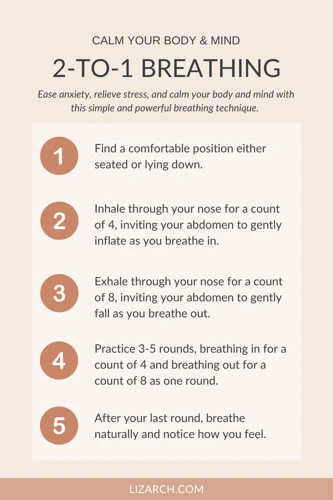Have you ever felt overwhelmed by the stress and chaos of daily life? Do you struggle to find inner peace and clarity? Mindfulness meditation might be just what you need. This ancient practice has been gaining popularity as a way to enhance mental health and well-being. By focusing your attention on the present moment and observing your thoughts and feelings without judgment, mindfulness can help you break free from negative patterns and cultivate a more positive and peaceful mindset. However, many people find it difficult to stay present and focused during meditation, which is where breath counting comes in. This simple technique can enhance your mindfulness practice and help you achieve greater serenity and awareness. Let’s explore how it works and how you can incorporate it into your daily routine.
What Is Mindfulness Meditation?

Mindfulness is a buzzword that has been spreading across the globe, and meditation is part of it. Although mindfulness meditation has been around for centuries, many people still don’t understand what it entails. Mindfulness meditation is a practice centered around being present and aware of the current moment while managing emotions and thoughts regarding the past or future. It is a form of mental training that can teach you how to concentrate on the breath or other objects of focus, and that’s where breath counting comes in. Let’s take a closer look into mindfulness meditation and how it can benefit us.
Benefits of Mindfulness Meditation
Mindfulness meditation has numerous benefits that can positively impact your mental and physical well-being. Here are some of the benefits listed below:
- Reduced stress: Mindfulness meditation helps in reducing the levels of cortisol, the stress hormone, in the body. This leads to decreased anxiety and overall feelings of calmness.
- Improved focus: Regular practice of mindfulness meditation strengthens the prefrontal cortex, which is the part of the brain responsible for attention and focus.
- Better emotional regulation: By focusing on the present moment, mindfulness meditation can help regulate your emotions and decrease negative emotions such as anger or frustration.
- Boosts immune system: Mindfulness meditation can boost the immune system by increasing activity in the prefrontal cortex, which is responsible for regulating the immune system’s response to infection and disease.
- Improved cognitive function: By increasing focus and reducing stress, mindfulness meditation can improve cognitive functions such as memory, creativity, and problem-solving abilities.
- Increased feelings of well-being: Regular practice of mindfulness meditation promotes feelings of gratitude, kindness, and compassion, leading to an overall sense of well-being and happiness.
Incorporating mindfulness meditation into your daily routine can provide long-term benefits that can enhance your overall quality of life. Take the time to practice regularly and experience the positive impact on your mental and physical well-being.
Breath Counting Technique

As mindfulness meditation continues to gain popularity, more and more people are looking for ways to enhance their practice. One technique that has proven to be effective is breath counting. By focusing on the breath and counting each inhale and exhale, practitioners can deepen their sense of awareness and inner peace. In this section, we’ll explore how breath counting works, provide a step-by-step guide, and offer tips on how to integrate this technique into your current meditation practice.
How Does It Work?
Breath counting is an effective technique that helps improve focus and concentration during mindfulness meditation. But how does it work?
The mechanics behind breath counting
Breath counting works by training the mind to focus on the breath and count with each inhalation and exhalation. This helps to improve awareness of the present moment and prevent the mind from wandering. It also helps to slow down breathing, which can have a calming effect on the body and mind.
The physiological effects of breath counting
Research has shown that using breath counting during meditation can have a range of physiological benefits. These include:
| Physiological Benefit | Description |
|---|---|
| Reduced stress | Breath counting can help reduce the activity of the sympathetic nervous system, which is responsible for the ‘fight or flight’ response. |
| Improved heart rate variability | Breath counting can help improve heart rate variability, which is linked to improved overall health and reduced risk of cardiovascular disease. |
| Lowered blood pressure | Studies have shown that mindfulness meditation, including breath counting, can help reduce blood pressure in people with hypertension. |
| Improved sleep | Breath counting can help promote relaxation, which can lead to improved sleep quality and duration. |
Breath counting is a simple yet powerful technique that can help enhance mindfulness meditation and bring about a range of health benefits.
Step-by-Step Guide
To practice the breath counting technique for mindfulness meditation, follow the step-by-step guide below:
- Find a quiet place: Choose a quiet space where you feel comfortable and can focus without distractions. Turn off your phone or put it on silent mode to avoid any interruptions.
- Sit comfortably: Find a comfortable seated position with your spine straight and your shoulders relaxed. You can sit on a cushion, chair, or the floor. Make sure your body feels relaxed and at ease.
- Set a timer: Set a timer for your chosen amount of meditation time. Start with a shorter session of just a few minutes, and gradually increase the time as you become more comfortable with the practice.
- Focus on your breath: Take a few deep breaths to relax your body and then breathe naturally. Focus your attention on the sensation of your breath as it moves in and out of your body.
- Count your inhalations: As you breathe in, silently count “one” in your mind. When you breathe out, count “two”. Continue counting each inhalation and exhalation up to “ten”.
- Restart the count: Once you reach ten, start the count over again at one. If you lose track or get distracted, simply start over at one.
- Be gentle with yourself: If your mind wanders or you lose track of the count, don’t judge or criticize yourself. Simply notice the distraction and gently bring your focus back to your breath.
- End your practice: When your timer goes off, take a few deep breaths and gradually bring yourself back to the present moment. Take a moment to notice how you feel before getting up and continuing with your day.
Remember that consistency is key with any meditation practice. It’s okay if you find it difficult to focus or if your mind wanders – this is all part of the process. With time and practice, you’ll be able to cultivate mindfulness and stay more present in your daily life.
Common Mistakes to Avoid
When practicing the breath counting technique, there are some common mistakes that often result in the lack of progress or even a negative experience. Here are some mistakes to avoid while practicing this technique:
| Mistake | Why It’s a Problem | How to Avoid It |
|---|---|---|
| Counting too fast or slow | Counting too fast or slow can interfere with the natural rhythm of breathing, making it difficult to relax and focus. | Count at a comfortable pace, keeping in sync with your own breath. |
| Getting distracted by other thoughts | It’s common for the mind to wander, but getting carried away by other thoughts can disrupt the practice and take you away from your focus point. | When you notice your mind wandering, simply acknowledge the thought and bring your focus back to the breath count without judging yourself. |
| Breathing irregularly | Inconsistent breathing can make it difficult to maintain focus and create a calming experience for your body. | Try to maintain steady, relaxed breathing throughout the practice, focusing on the natural rhythm of each inhale and exhale cycle. |
| Expecting immediate results | This technique is a form of meditation, and like all meditative practices, it requires patience and regular practice to truly see the benefits. | Set realistic expectations for yourself and remember that progress takes time. Aim to practice regularly without placing too much pressure on immediate results. |
By avoiding these common mistakes, you can make the most of your breath counting practice, and enhance your overall mindfulness meditation experience. Remember to stay patient, consistent, and attentive to the present moment as you work towards a greater sense of calm and clarity.
Tips to Use Breath Counting for Meditation
When it comes to enhancing your mindfulness meditation practice, the breath counting technique can be a powerful tool. However, just like any other meditation technique, it takes time, patience, and consistency to master it. Here are some tips on how to use breath counting effectively during your meditation sessions to experience its benefits to the fullest:
Integrate Breath Counting With Your Existing Practice
One of the best ways to use the breath counting technique to enhance your mindfulness meditation is to integrate it with your existing practice. This means incorporating it into your regular meditation routine.
Why integrate breath counting?
Integrating breath counting into your existing practice can help you improve your focus and concentration during meditation. It can also help you develop a deeper connection with your breath and body, which can lead to greater relaxation and mental clarity.
How to integrate breath counting
Here are some steps you can take to integrate breath counting with your existing practice:
| Step | Description |
|---|---|
| 1 | Start by practicing breath counting for just a few minutes each day, in addition to your existing meditation practice. |
| 2 | Gradually increase the amount of time you spend on breath counting until it becomes a regular part of your practice. |
| 3 | Try switching back and forth between your regular meditation practice and breath counting practice to keep things fresh and interesting. |
| 4 | Experiment with incorporating different types of breath awareness techniques into your practice, such as focusing on the sensation of the breath moving in and out of the body. |
Benefits of integrating breath counting into your practice
By integrating breath counting into your existing practice, you can reap a number of benefits. Here are some of the key advantages:
- Improved focus and concentration
- Deeper relaxation
- Greater awareness of your breath and body
- Reduced stress and anxiety
Conclusion
Integrating breath counting into your existing practice is an effective way to deepen your mindfulness meditation practice. By following the steps outlined above and being consistent in your efforts, you can improve your focus, concentration, and overall well-being.
Set Realistic Goals
It is important to set realistic goals when incorporating the breath counting technique into your mindfulness meditation practice. This will help you stay motivated and ensure that you do not become discouraged.
One way to set realistic goals is to start with a small number of breaths to count, such as 5 or 10. As you become more comfortable with the technique, you can gradually increase the number of breaths you count.
Another strategy is to set a specific amount of time for your meditation practice each day. This could be as little as 5 minutes or as much as 30 minutes, depending on your schedule and level of experience.
It is also important to be flexible with your goals. Some days, you may need to adjust the amount of time or number of breaths you count based on how you are feeling physically or mentally.
To keep yourself on track, it may be helpful to keep a journal of your progress. This could include the number of breaths you counted each day, the amount of time you spent meditating, and any thoughts or emotions that came up during your practice.
By setting realistic goals and tracking your progress, you can stay motivated and continue to reap the benefits of mindfulness meditation with the breath counting technique.
| Strategies for Setting Realistic Goals: |
|---|
| Start with a small number of breaths to count |
| Set a specific amount of time for your meditation practice each day |
| Be flexible with your goals |
Be Consistent
Consistency is key to any successful meditation practice, and this is especially true when it comes to using the breath counting technique. One way to ensure consistency is to establish a regular meditation routine. Whether you choose to meditate once a day or multiple times a day, it’s important to stick to your routine as much as possible.
To help you stay consistent with your practice, consider setting reminders or alarms to alert you when it’s time to meditate. You could also create a designated meditation space in your home or office, which can serve as a visual reminder to take a few moments for yourself.
Another way to maintain consistency is to approach your practice with a non-judgmental attitude. It’s important to remember that progress takes time, and it’s okay to have days where your mind feels particularly busy or distracted. Instead of beating yourself up for not achieving a certain level of concentration, focus on the process of meditation itself.
Consistency also means being patient with yourself. As with any new habit, it can take time to establish a consistent meditation routine. Instead of getting discouraged if you miss a day, try to approach your practice with a sense of curiosity and openness. What can you learn from the experience of missing a day? Are there any patterns or obstacles that are getting in the way of your consistency?
Ultimately, the most important thing is to keep practicing. Even if you miss a day or fall out of your routine, simply pick up where you left off and keep going. Over time, consistent practice will help you build the focus and awareness needed to fully experience the benefits of mindfulness meditation.
Conclusion
In conclusion, breath counting is a simple yet effective technique that can enhance your mindfulness meditation practice. By focusing on the breath, you can improve your concentration, reduce stress and anxiety, and develop a greater sense of self-awareness.
It’s important to remember that mindfulness meditation is not a quick fix, but rather a long-term practice that requires patience and dedication. Incorporating breath counting into your daily routine can be a powerful tool for cultivating mindfulness and inner peace.
Remember to start small, setting realistic goals and incorporating breath counting into your existing practice. Avoid common mistakes, such as getting caught up in thoughts or becoming frustrated with your progress. Instead, approach your practice with curiosity and a sense of openness, embracing both the successes and the challenges along the way.
Overall, breath counting can be a valuable addition to your mindfulness meditation repertoire, helping you to find greater clarity, peace of mind, and presence in the moment. So take a deep breath, let go of any expectations, and begin your journey towards greater mindfulness and well-being today.
Frequently Asked Questions
Can anyone practice mindfulness meditation?
Yes, anyone can practice mindfulness meditation. It is a simple and accessible practice that can benefit anyone who is willing to try it.
What kind of benefits can I expect from practicing mindfulness meditation?
Practicing mindfulness meditation can help reduce stress and anxiety, improve focus and concentration, increase self-awareness and emotional intelligence, and enhance overall well-being.
What is the breath counting technique?
The breath counting technique is a simple and effective method of enhancing mindfulness meditation. It involves counting each breath to help focus the mind and cultivate concentration.
How does the breath counting technique work?
The breath counting technique works by providing a focused and repetitive task for the mind to concentrate on. By counting each breath, the mind becomes more aware of the present moment, which can enhance the benefits of mindfulness meditation.
What is the step-by-step guide for practicing the breath counting technique?
The steps for practicing the breath counting technique are: 1) find a comfortable sitting position, 2) begin breathing naturally, 3) count each inhale and exhale, up to a number of your choice, 4) start over at one and repeat for a designated period of time.
What are some common mistakes to avoid when practicing the breath counting technique?
Some common mistakes to avoid when practicing the breath counting technique include: losing track of the count, getting frustrated or distracted if the mind wanders, and trying to control or force the breath in any way.
How can I integrate breath counting with my existing mindfulness meditation practice?
You can integrate breath counting with your existing mindfulness meditation practice by adding it as a component or focusing on it for a designated period of time. Gradually increase the number of breaths you count as your concentration improves.
What is a realistic goal for practicing the breath counting technique?
A realistic goal for practicing the breath counting technique is to start with counting up to 10 breaths and gradually increasing the count over time. The goal is to improve concentration and mindfulness, not to reach a certain number.
How often should I practice the breath counting technique?
It is recommended to practice the breath counting technique for at least 10-15 minutes per day, once or twice per day. Consistency is key to experiencing the benefits of mindfulness meditation.
Can I use the breath counting technique outside of meditation?
Yes, you can use the breath counting technique outside of meditation to help focus the mind and increase mindfulness in daily life. It can be particularly helpful during moments of stress or overwhelm.








